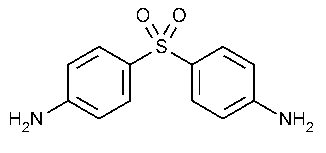Dapsone
»Dapsone contains not less than 98.0percent and not more than 102.0percent of C12H12N2O2S,calculated on the dried basis.
Packaging and storage—
Preserve in well-closed,light-resistant containers.
Identification—
A:
Infrared Absorption á197Kñ.
Solution:
5µg per mL.
Medium:
methanol.
Loss on drying á731ñ—
Dry it at 105 for 3hours:it loses not more than 1.5%of its weight.
for 3hours:it loses not more than 1.5%of its weight.
Residue on ignition á281ñ:
not more than 0.1%.
Selenium á291ñ:
0.003%,a 100-mg test specimen,mixed with 100mg of magnesium oxide,being used.
Chromatographic purity—
Standard solutions—
Dissolve USP Dapsone RSin methanol and mix to obtain Standard solution Ahaving a known concentration of 12.5mg per mL.Dilute quantitatively with methanol to obtain Standard solution B,containing 125µg of the Reference Standard per mL,and Standard solution C,containing 62.5µg of the Reference Standard per mL.
Test solution—
Dissolve an accurately weighed quantity of Dapsone in methanol to obtain a solution containing 12.5mg per mL.
Procedure—
[NOTE—Prepare the solvent system fresh daily.Equilibrate the chromatographic chamber with the solvent system for 30minutes prior to development of the chromatographic plate.]Separately apply 4µLof the Test solutionand each of the Standard solutionsto a suitable high-performance thin-layer chromatographic plate (see Chromatography á621ñ)coated with a 150-to 200-µm layer of chromatographic silica gel.Dry the applications with the aid of a stream of nitrogen.Position the plate in a chromatographic chamber,and develop the chromatograms in a solvent system consisting of a mixture of chloroform,acetone,n-butyl alcohol,and formic acid (60:15:15:10)until the solvent front has moved about three-fourths of the length of the plate.Remove the plate from the developing chamber and air-dry.Spray the plate lightly with a 0.1%(w/v)solution of 4-dimethylaminocinnamaldehyde in a mixture of equal volumes of glacial acetic acid and water.Examine the spots that are developed immediately,and compare the intensities of any secondary spots observed in the chromatogram of the Test solutionwith those of the principal spots in the chromatogram of the Standard solutions:no secondary spot from the chromatogram of the Test solutionis larger or more intense than the principal spot obtained from Standard solution C(0.5%),and the sum of the intensities of all the secondary spots obtained from the Test solutioncorresponds to not more than 1.0%.
Organic volatile impurities,Method Vá467ñ:
meets the requirements.
Solvent—
Use dimethyl sulfoxide.
Assay—
Mobile phase—
Transfer 100mLof isopropyl alcohol,100mLof acetonitrile,and 100mLof ethyl acetate to a 1000-mLvolumetric flask.Add pentane to volume without mixing,then mix,and allow the mixture to cool to room temperature.
Standard preparation—
Dissolve an accurately weighed quantity of USP Dapsone RSin methanol to obtain a solution having a known concentration of about 250µg per mL.Pipet 5mLof this solution into a 50-mLvolumetric flask,dilute with Mobile phaseto volume,and mix to obtain a Standard preparationhaving a known concentration of about 25µg per mL.
Assay preparation—
Transfer about 50mg of Dapsone,accurately weighed,to a 200-mLvolumetric flask.Dissolve in methanol,dilute with methanol to volume,and mix.Pipet 5mLof this solution into a 50-mLvolumetric flask,dilute with Mobile phaseto volume,and mix.
Chromatographic system(see Chromatography á621ñ)—
The chromatograph is equipped with a 254-nm detector and a 4-mm ×30-cm column that contains 10-µm diameter packing L3.Chromatograph a sufficient number of injections of the Standard preparationas directed for Procedure:the relative standard deviation is not more than 2%.
Procedure—
Separately introduce equal volumes (about 10µL)of the Standard preparationand the Assay preparationinto the chromatograph by means of a suitable microsyringe or sampling valve,adjusting the specimen size and other operating parameters to obtain satisfactory chromatograms.Measure the responses for the major peaks obtained at corresponding retention times with the Assay preparationand the Standard preparation.Calculate the quantity,in mg,of C12H12N2O2Sin the portion of Dapsone taken by the formula:
2C(PU/PS),
in which Cis the concentration,in µg per mL,of USP Dapsone RSin the Standard preparation;and PUand PSare the peak responses obtained from the Assay preparationand the Standard preparation,respectively.
Auxiliary Information—
Staff Liaison:Behnam Davani,Ph.D.,MBA,Senior Scientist
Expert Committee:(PA7)Pharmaceutical Analysis 7
USP28–NF23Page 572
Phone Number:1-301-816-8394
